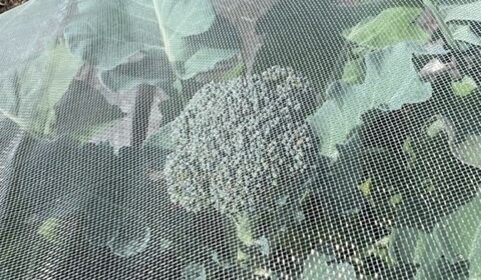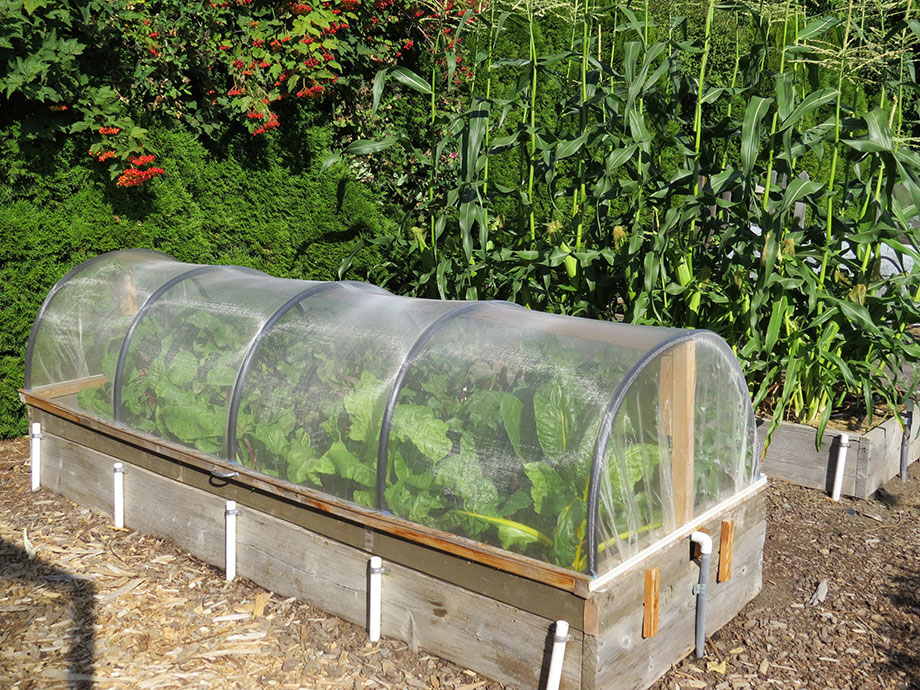Sept. 18 Column: Agricultural insect netting


If you’ve been following me this year, you know I’ve been experimenting with agricultural insect netting. I promised early in the season that I would give an official report on how it performed. That’s what today’s column is all about! You can read it in The Spokesman-Review: Garden insect netting is a game-changer for crops that attract bugs. Or you can read my column underneath the video below.
Also referred to as “garden insect netting” or “agricultural mesh,” I purchased it from agfabric.com (NOTE: I just learned that agfabric’s website is now called gardenport.com.) But if you do a web search on the above terms, you likely will find other sources for it as well. The bottom line is that I am so impressed with this netting! The true test was seeing if it would keep aphids off our broccoli plants and yes, it does. There isn’t a single aphid on them and if you grow cabbage family crops, you know how troublesome aphids can be.
From a gardening perspective, the frustrating thing is that it is very smoky here in Spokane. That means I really have to limit my time outdoors to a minimum. So I ended up shooting this week’s video indoors, although as I explain in the video introduction, I had planned that anyway. The topic is spring-blooming bulbs that you plant in the fall. While it’s too early to plant bulbs, I wanted to give an introduction to them which includes important considerations to keep in mind while shopping for them. I fully intend to shoot a video on planting bulbs once the temperatures drop. In the meantime, I hope you’ll enjoy this video:
Here’s my garden column:
by Susan Mulvihill
I have been a proponent of floating row cover for years. When placed on hoops over a vegetable crop, this lightweight fabric allows sunlight and moisture to pass through it and acts as a physical barrier to keep certain types of damaging insects away from susceptible crops.
I primarily use lightweight row cover for that purpose but there also are heavier weights that give plants a few degrees of frost protection.
There are two things I don’t like about floating row cover: you have to lift it off the crop to see how the plants are doing and it doesn’t provide good air circulation underneath it. That first issue is a big one for me because, once I cover a crop, it turns into one of those “out of sight, out of mind” situations. It’s very easy to ignore what’s growing underneath and miss harvesting at important intervals during the season.
This year, I tried something new and it has changed my gardening life. For the last few years, I kept hearing about a product called agricultural mesh that British gardeners use to protect certain crops from insect or bird damage. It looked very appealing yet I couldn’t locate any to test in my garden.
In January, my luck changed. I found it on a website and ordered enough to cover three raised beds. I typically use row cover over cabbage family crops (primarily broccoli) to keep cabbage worms and aphids away, and over beet family crops to thwart leafminers. None of these crops needs to be pollinated, which means I can leave the covers on for the whole season. I rarely have serious insect problems with the other crops that I grow.
When my order arrived, I was anxious to see how sturdy it is and how well I could see through it. Also known as garden insect netting, it immediately passed both tests: it’s very durable and very easy to look through.
Bill and I made two hinged lids for a couple of our raised beds; the lids are a do-it-yourself project in my book, “The Vegetable Garden Pest Handbook.” Instead of covering them with floating row cover, we used some of the insect netting.
One cover was for the lettuce bed, primarily to keep birds away from the leaves, but I followed that crop with a planting of insect-attracting cabbage. The other cover went over the beet and Swiss chard bed because I know how much damage leafminers can cause.
It has been such a treat to easily see the plants without having to lift the lids. I could tell when to harvest leaves from the chard plants or pick lettuce.
I also set up a hoop system over the broccoli bed and covered it with a sheet of insect netting. Its transparent nature helped me see when it was time to cut off the primary heads on the broccoli plants and, later, the many secondary heads. The best part of all was the complete lack of aphids – as well as cabbage worms – on the leaves. I also believe that the broccoli plants produced for a longer period of time because of the good air circulation underneath the cover.
I fully expect to get several years of use out of the insect netting since it’s so well-made. If you’re interested in locating some sources, just do a web search using “agricultural mesh” or “garden insect netting” for your criteria.
Susan Mulvihill is author of “The Vegetable Garden Problem Solver Handbook” and “The Vegetable Garden Pest Handbook.” She can be reached at Susan@SusansintheGarden.com. Watch this week’s video at youtube.com/susansinthegarden.
